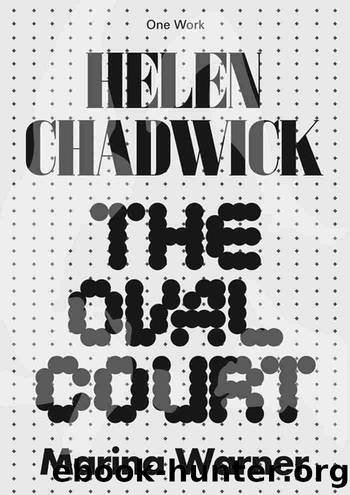Helen Chadwick by Marina Warner

Author:Marina Warner [Warner, Marina]
Language: eng
Format: epub
Publisher: MIT Press
Published: 2022-08-03T00:00:00+00:00
I first met Helen Chadwick in person in l985 at the show of Ego Geometria Sum at the Riverside Studios. We had arranged to meet there to discuss her taking part in a documentary film about women artists and their use of the female form. I was with Gina Newson, the director of the programme, which was commissioned by Channel Four, and eventually went out in 1986 under the title Imaginary Women. Helen was invited to join an onscreen âdinner partyâ staged in homage to Judy Chicago's notorious installation of 1979, which celebrated thirty-nine foremothers and rendered each of them as a customised plate decorated with symbolic imagery, often explicitly sexual. Among the other guests were Susan Hiller, Rose Garrard and Kate Blacker; I was the host, trying to keep the conversation on track. The arguments before us arose from Monuments & Maidens: The Allegory of the Female Form (1985), which I had just published. In this book, I ask why Liberty and Justice, and any number of other concepts â including nations, arts, sciences, manufactures â should be represented as female in traditional iconography. From the Greeksâ imagery of cities and Christian virtues, to nineteenth-century celebrations of new inventions and technologies (âElectricityâ appears in some French mairies as a half-clad nymph), the female form has been annexed to express ideals and other abstractions. Alongside many feminists of my generation, I demanded that women artists occupy these sites of meaning and make them their own. Newly embodied, they would then speak in their own voices from their experience and endow the abstractions with consciousness. Rose Garrard had enjoyed resounding success for her series of self-portraits re-investing personal meaning into figures such as Pandora, the first woman of Greek mythology, who, like Eve, was blamed for the fall of humanity. Susan Hiller had disrupted one convention after another in the tradition of female self-presentation, for example with a sequence of timed photographs of her pregnant body; she was also experimenting with alternative portraiture through handwriting, and, like Chadwick, with photobooth snapshots.
The discussion was to follow the ancient model of the Symposium: each artist had her turn to speak, and the others were to comment. When we turned to Helen Chadwick, she was challenged for not showing sufficient resistance to dominant conventions around female nudity, for displaying herself naked and apparently soliciting the male gaze. At one point, after Helen had hotly defended her self-presentations, Susan Hiller quipped, âBut you do look kinda cute.â
The film is now a curio, but it has historical value as a record of the struggle of women artists to be heard and valued. Such an assembly is no longer exceptional or marginalised and consequently women who make art are not as defensive as they â we â were then. But above all, the principle of self-creation through performance and autobiographical self-portraiture, as pursued by Frida Kahlo or Jo Spence, has become a fundamental process in the arts (not only the visual arts) and has spread throughout public communications and social media.
Download
This site does not store any files on its server. We only index and link to content provided by other sites. Please contact the content providers to delete copyright contents if any and email us, we'll remove relevant links or contents immediately.
Technical Art History by Jehane Ragai(456)
Art, Science, and the Natural World in the Ancient Mediterranean, 300 BC to AD 100 by JOSHUA J. THOMAS(410)
Graphic Culture by Lerner Jillian;(397)
The Slavic Myths by Noah Charney(368)
Pollak's Arm by Hans von Trotha(340)
Treasuring the Gaze by Hanneke Grootenboer(337)
Simply Artificial Intelligence by Dorling Kindersley(336)
Sketchbook Confidential: Secrets from the private sketches of over 40 master artists by Editors of North Light Books(336)
The Art of Portrait Drawing by Cuong i(331)
Drawing for the Soul by Zoë Ingram(326)
Drawing Landscapes by Barrington Barber(320)
Mountain Manâs Field Guide to Grammar by Gary Spina(312)
The Art of Painting Sea Life in Watercolor by Maury Aaseng Hailey E. Herrera Louise De Masi and Ronald Pratt(310)
Portrait of a Woman by Bridget Quinn(299)
Anatomy for the Artist by Jennifer Crouch(292)
A text-book of the history of painting by Van Dyke John Charles 1856-1932(288)
Preparing Dinosaurs by Wylie Caitlin Donahue;(281)
Botanical Illustration by Valerie Price(280)
Egyptian art by Jean Capart(277)
